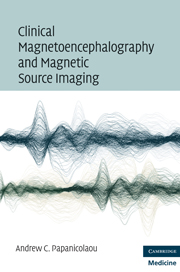Book contents
- Frontmatter
- Contents
- Contributors
- Preface
- Section 1 The method
- Section 2 Spontaneous brain activity
- Section 3 Evoked magnetic fields
- 19 Recording evoked magnetic fields (EMFs)
- 20 Somatosensory evoked fields (SEFs)
- 21 Movement-related magnetic fields (MRFs) – motor evoked fields (MEFs)
- 22 Auditory evoked magnetic fields (AEFs)
- 23 Visual evoked magnetic fields (VEFs)
- 24 Language-related brain magnetic fields (LRFs)
- 25 Alternative techniques for evoked magnetic field data – future directions
- Postscript: Future applications of clinical MEG
- References
- Index
25 - Alternative techniques for evoked magnetic field data – future directions
from Section 3 - Evoked magnetic fields
Published online by Cambridge University Press: 01 March 2010
- Frontmatter
- Contents
- Contributors
- Preface
- Section 1 The method
- Section 2 Spontaneous brain activity
- Section 3 Evoked magnetic fields
- 19 Recording evoked magnetic fields (EMFs)
- 20 Somatosensory evoked fields (SEFs)
- 21 Movement-related magnetic fields (MRFs) – motor evoked fields (MEFs)
- 22 Auditory evoked magnetic fields (AEFs)
- 23 Visual evoked magnetic fields (VEFs)
- 24 Language-related brain magnetic fields (LRFs)
- 25 Alternative techniques for evoked magnetic field data – future directions
- Postscript: Future applications of clinical MEG
- References
- Index
Summary
Spectral analysis of MEG data
In parallel to the analysis of ERFs, the frequency domain of MEG data can be explored in terms of power at single-sensor locations or functional coupling between pairs of sensors (or pairs of sources).
Event-related desynchronization (ERD) and event-related synchronization (ERS)
ERD and ERS of EEG or MEG rhythms describe neuroelectric events preceding and following a task execution. ERD/ERS may reveal a reduction or increase in EEG power during an event – sensory, cognitive, motor – when compared to baseline at a certain frequency band.
Temporal spectral evolution (TSE)
An alternative procedure frequently used for MEG data is the TSE analysis, which provides an index of event-related changes in the magnitude of the magnetic fields in the physical unit of the recording.
Coherence
The functional coupling of brain rhythms, spectral coherence analysis indexes the temporal synchronization of two EEG or MEG time series (i.e., relative to two sensors), in frequency domain (i.e., frequency-by-frequency), and helps to assess linear functional cortico-cortical connectivity. In general, decreased coherence indices reduce linear functional connections and information transfer (i.e., uncoupling) between cortical areas beneath the paired electrodes or modulation of common areas by a third region. In contrast, increased coherence augments linear functional connections and information transfer (i.e., coupling), which reflects a functional interaction of different corticaldraftrules structures for a given task.
Direct transfer function (DTF)
Finally, the direction of the information flow within the coupled EEG rhythms can be estimated by the DTF approach.
- Type
- Chapter
- Information
- Clinical Magnetoencephalography and Magnetic Source Imaging , pp. 157 - 170Publisher: Cambridge University PressPrint publication year: 2009



